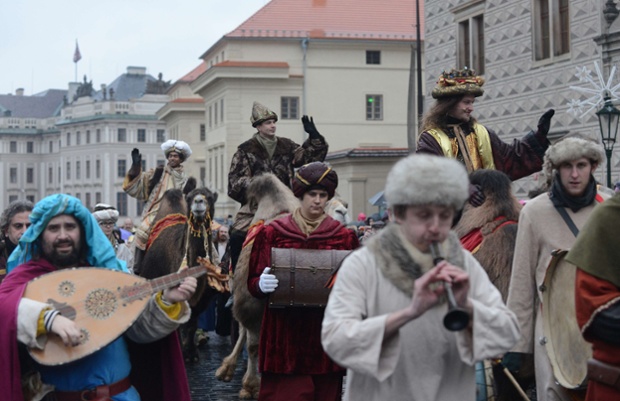Like press coverage more generally, photojournalism doesn’t really know what to do with religion. Most of what is meaningful to the pious is experienced internally, subjectively, and away from the public gaze, while most of what is observable by outsiders can appear arbitrary, archaic, or ridiculous (or all three).
This procession through the streets of Prague to celebrate the festival of Epiphany would seem to qualify. The mashup of Babylonian and medieval costumes seems right out of an old oil painting. The alternation of festive and dutiful attitudes among the performers also seems appropriate, as between them they ensure that the ritual is only that and not an occasion for getting closer to God.
Most visual coverage of religion probably goes no further than the categories of Ritual, Rapture, and Violence: we watch as the devoted go through their curious motions, or are overcome by powerful emotions of anguished penance or spiritual connection, or are killing other people for having made the mistake of being born into the wrong faith. Come to think of it, that does cover quite a bit of ground. . . .
Even so, much still is being overlooked, and perhaps necessarily so. Any medium has its limits, whether the medium is spiritual or technological. Let me suggest that something might be there to be learned nonetheless, and not just about religion.
I selected the photo above because it is actually among the more mundane examples of the season. Between slow news cycle around Christmas and the end of year/new year transition, the slide shows are full of eye candy, and especially from the religious festivals. The photo above falls within that pattern, but also within the dull routines, muted emotions, and general banality of the midwinter, work-a-day world that awaits everyone once the holidays are over. That aesthetic and social downtime corresponds to what is known in the Christian liturgical calendar as Ordinary Time. (I love that label.) In the photo above, it’s almost as if the procession is passing through an aperture in time, moving methodically from the temporary, ritualized, make-believe disruptions provided by the holidays into the unif0rm, linear time of a modern, secular society. I can almost imagine them going around the corner and vanishing, leaving only an empty street on another cloudy day.
Modernity itself knows no time other than ordinary time, an endless progression forward without any possibility for magical interludes, eternal returns, or other supernatural distortions. So it is that religion, like violence, typically is thought of as a pre-modern holdover, another form of traditional folk culture that stubbornly persists but eventually will become negligible.
That may be, and that may be for the best, but I think the photograph above slyly suggests another possibility. Instead of simply vanishing, perhaps, like the group in The Journey to the East, they might continue to exist after others stop believing in them; perhaps they could travel into another world, one of many alongside this one in a time out of time. The procession would still be silly, somber, peculiar, and otherwise out of joint with the modern world, and the difference would be our loss.
Photograph by Michal Cizek/AFP-Getty Images.

A Pope keeping up with the times –
http://www.efn.org/~hkrieger/xc037.jpg
frm the series, “Churches ad hoc”.